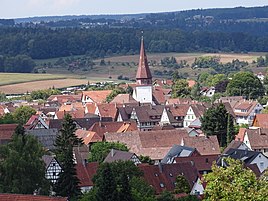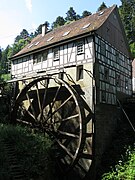Stammheim (Calw)
|
Stammheim
City of Calw
|
|
|---|---|
| Coordinates: 48 ° 41 ′ 45 ″ N , 8 ° 46 ′ 16 ″ E | |
| Height : | 461 m above sea level NHN |
| Residents : | 4854 (Oct. 31, 2014) |
| Incorporation : | 1st January 1975 |
| Incorporated into: | Calw-Hirsau |
| Postal code : | 75365 |
| Area code : | 07051 |
|
Stammheim, town center with Martinskirche
|
|
Stammheim is part of the district town of Calw in Baden-Württemberg .
geography
Stammheim has almost 5000 inhabitants and is located in a fertile hollow of the Heckengäus on the eastern edge of the Black Forest at an altitude of 469 m above sea level. NHN . The highest point in Stammheim is marked by the thumb (Swabian: Doma ) at 610.4 m above sea level. NHN .
The source of the Schlittenbach and the Rehgrundbrünnele , from which the Rehgrundklinge arises, is located in Stammheim .
history
Due to its favorable location, the place was settled early and is considered one of the oldest settlements in the region. There are archaeological finds of a Celtic settlement from the 5th century BC. A Roman villa rustica was excavated in the area of the Protestant youth home . Alemannic graves were discovered in 1973 . From Stammheim, the Black Forest was Christianized towards the west, and a branch church was built in Kentheim .
The first documentary mention comes from around 830. In the Middle Ages the village belonged to the Hirsau Monastery and came to the Duchy of Württemberg during the Reformation . In the valley there was a Niederadelsburg, which was partially excavated in 1968/69 by the then State Office for the Preservation of Monuments. Shortly before the end of the Second World War , about 40% of the historic core of Stammheim was destroyed in an Allied air raid and a subsequent fire, killing five people.
As part of the Baden-Württemberg community reform , Stammheim was incorporated into Calw-Hirsau on January 1, 1975. On January 1, 1976, the name of the town was changed from Calw-Hirsau to Calw.
Former municipal coat of arms
| Blazon : "In red a golden Astschrägbalken, a growing from the right shield lower margin, left-turned golden Abtsstab crossing." | |
education
Stammheim has three kindergartens, a primary school , a special school , a speech therapy center and the general education Maria-von-Linden-Gymnasium .
Culture and sights
The traditional outdoor pool, which was renovated in 2004/2005, is a particular attraction for around 200,000 people annually. In addition, the nearby Black Forest with its healing springs and the Schönbuch with numerous hiking trails attracts many tourists to the region.
- The Martinskirche of the Evangelical Parish Stammheim-Holzbronn in the center of the village is the oldest building. It is the spiritual center of the local community belonging to the Calw-Nagold church district in the Evangelical Church in Württemberg . The tower was built in the 11th century and heightened at the end of the 17th century, the choir vault probably dates from the 15th century. The well-preserved frescoes are also worth seeing . A previous church already belonged to the Hirsauer Stiftsgut in 830, to which it was incorporated in 1326. Today's church is a late baroque building from 1790 with the choir tower of the previous church. During the renovation from 1929–1931, the four-part south window (Old Testament: Jakobs Himmelsleiter, Jakob am Jabbok; New Testament: poor Lazarus and the Rich) were designed by the Stuttgart painter Berger and executed by the Wilhelm workshop in Rottweil. The glass artist Wolf-Dieter Kohler created the baptismal window, the Martin window and a narrow ornament window in 1964.
- The fisherman's house opposite the Martinskirche, a half-timbered house from 1569, was rebuilt in 1729 and survived the fire disaster of 1945 undamaged.
- The Schlössle was built in 1288 and in the 14th century was owned by the barons of Waldeck Castle , later owned by the Hirsau Monastery . After a fire around 1400 it was rebuilt and expanded in 1491 by the abbot Blasius von Hirsau with a new building. Today's main house was built in 1746.
- In addition, there is the largest wooden overshot mill wheel in Europe in the Schleiftal valley at the Untere Mühle, which belongs to Stammheim .
Individual evidence
- ↑ Map services of the Federal Agency for Nature Conservation ( information )
- ^ Federal Statistical Office (ed.): Historical municipality directory for the Federal Republic of Germany. Name, border and key number changes in municipalities, counties and administrative districts from May 27, 1970 to December 31, 1982 . W. Kohlhammer, Stuttgart / Mainz 1983, ISBN 3-17-003263-1 , p. 488 f .
- ^ Website of the Evangelical Church Community in Stammheim-Holzbronn
- ^ Entry on Stammheim Castle (Schlössle) in the private database "Alle Burgen". Retrieved December 4, 2018.
- ^ HW Heine: Little-known castle places in the Calw district . In: Landesdenkmalamt Baden-Württemberg (Hrsg.): Preservation of monuments in Baden-Württemberg . 7th year January-March 1978, p. 34 ff . ( uni-heidelberg.de ).
- ↑ Nature meets culture on the homepage of the city of Calw. Retrieved February 12, 2016.
literature
- Horst Roller, Hellmut J. Gebauer: Stammheim. In: Calw - History of a City. Calw 2009, ISBN 978-3-939148-21-0 .











